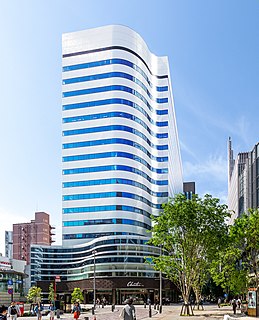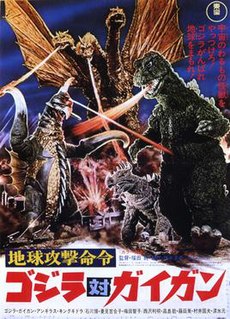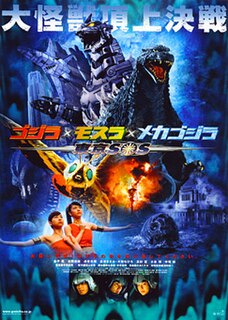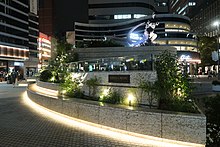
Godzilla is a fictional monster, or kaiju, originating from a series of Japanese films. The character first appeared in the 1954 film Godzilla and became a worldwide pop culture icon, appearing in various media, including 32 films produced by Toho, four Hollywood films and numerous video games, novels, comic books and television shows. Godzilla has been dubbed the "King of the Monsters", a phrase first used in Godzilla, King of the Monsters! (1956), the Americanized version of the original film.

Godzilla is a 1954 Japanese kaiju film directed by Ishirō Honda, with special effects by Eiji Tsuburaya. Produced and distributed by Toho Studios, it is the first film in the Godzilla franchise and the Shōwa era. The film stars Akira Takarada, Momoko Kōchi, Akihiko Hirata, and Takashi Shimura, with Haruo Nakajima and Katsumi Tezuka as Godzilla. In the film, Japan's authorities deal with the sudden appearance of a giant monster, whose attacks trigger fears of nuclear holocaust during post-war Japan.

The Return of Godzilla is a 1984 Japanese kaiju film directed by Koji Hashimoto, with special effects by Teruyoshi Nakano. The film features the fictional monster character Godzilla. Produced and distributed by Toho Studios, it is the 16th film in the Godzilla franchise, and is the first film to be produced in the Heisei era. In Japan, the film was followed by Godzilla vs. Biollante in 1989.

Toho Co., Ltd. is a Japanese film, theater production and distribution company. It has its headquarters in Chiyoda, Tokyo, and is one of the core companies of the Hankyu Hanshin Toho Group. Outside of Japan, it is best known as the producer and distributor of many kaiju and tokusatsu films, the Chouseishin tokusatsu superhero television franchise, the films of Akira Kurosawa, and the anime films of Studio Ghibli, TMS Entertainment and OLM, Inc. Other famous directors, including Yasujirō Ozu, Kenji Mizoguchi, Masaki Kobayashi, and Mikio Naruse, also directed films for Toho.

Kaiju is a Japanese genre of films and television featuring giant monsters. The term kaiju can refer to the giant monsters themselves, which are usually depicted attacking major cities and engaging the military, or other kaiju, in battle. The kaiju genre is a subgenre of tokusatsu entertainment.

Mothra is a fictional monster, or kaiju, that first appeared in the 1961 film Mothra, produced and distributed by Toho Studios. Mothra has appeared in several Toho tokusatsu films, most often as a recurring character in the Godzilla franchise. She is typically portrayed as a colossal sentient larva (caterpillar) or imago, accompanied by two miniature female humanoids speaking on her behalf. Unlike other Toho monsters, Mothra is a largely heroic character, having been variously portrayed as a protector of her own island culture, the Earth and Japan. Mothra’s design is influenced by silk worms, their imagos, and those of giant silk moths in the family saturniidae. The character is often depicted hatching offspring when approaching death, a nod to the Saṃsāra doctrine of numerous Indian religions.

Godzilla vs. Gigan, released in Japan as Chikyū Kōgeki Meirei: Gojira tai Gaigan, is a 1972 Japanese kaiju film directed by Jun Fukuda, written by Takeshi Kimura and Shinichi Sekizawa, and produced by Tomoyuki Tanaka, with special effects by Teruyoshi Nakano. Distributed by Toho and produced under their effects-based subsidiary Toho-Eizo, it is the 12th film in the Godzilla franchise, and features the fictional monster characters Godzilla, Gigan, Anguirus, and King Ghidorah. The film stars Hiroshi Ishikawa, Yuriko Hishimi, Tomoko Umeda, and Minoru Takashima, alongside Haruo Nakajima as Godzilla, Kenpachiro Satsuma as Gigan, Koetsu Omiya as Anguirus, and Kanta Ina as King Ghidorah. It is the last film in which Godzilla was portrayed by Nakajima after playing the character since the original 1954 film; he subsequently retired from suit acting.

Tokusatsu is a Japanese term for live action film or television drama that makes heavy use of special effects. Tokusatsu entertainment often deals with science fiction, fantasy or horror, but films and television shows in other genres can sometimes count as tokusatsu as well. The most popular types of tokusatsu include kaiju monster films such as the Godzilla and Gamera film series; superhero TV serials such as the Kamen Rider and Metal Hero series; and mecha dramas like Giant Robo and Super Robot Red Baron. Some tokusatsu television programs combine several of these subgenres, for example the Ultraman and Super Sentai series.

Godzilla vs. Destoroyah is a 1995 Japanese kaiju film directed by Takao Okawara, written by Kazuki Ōmori, and produced by Shōgo Tomiyama. Produced and distributed by Toho Studios, it is the 22nd installment in the Godzilla franchise, and is the seventh and final film in the franchise's Heisei period. The film features the fictional monster characters Godzilla, Godzilla Junior, and Destoroyah, and stars Takuro Tatsumi, Yōko Ishino, Yasufumi Hayashi, Sayaka Osawa, Megumi Odaka, Masahiro Takashima, Momoko Kochi, and Akira Nakao, alongside Kenpachiro Satsuma as Godzilla, Hurricane Ryu as Godzilla Junior, and both Ryo Hariya and Eiichi Yanagida as Destoroyah.

Mechagodzilla is a fictional mecha character that first appeared in the 1974 film Godzilla vs. Mechagodzilla. In its debut appearance, Mechagodzilla is depicted as an extraterrestrial villain that confronts Godzilla. In subsequent iterations, Mechagodzilla is usually depicted as a man-made weapon designed to defend Japan from Godzilla. In all incarnations, the character is portrayed as a robotic doppelgänger with a vast array of weaponry, and along with King Ghidorah, is commonly considered to be an archenemy of Godzilla.

Godzilla: Tokyo S.O.S. is a 2003 Japanese kaiju film directed by Masaaki Tezuka, written by Tezuka and Masahiro Yokotani, and produced by Shogo Tomiyama. Produced and distributed by Toho Studios, it is the 28th film in the Godzilla franchise, the fifth film in the franchise's Millennium series, the 27th Godzilla film produced by Toho, and a direct sequel to the 2002 film Godzilla Against Mechagodzilla. The film features the fictional monster characters Godzilla and Mothra, along with the mecha character Mechagodzilla, who is referred to in the film by the name Kiryu.

Zilla, formerly known as Godzilla, is a film monster originating from the 1998 film Godzilla, released by TriStar Pictures. It was initially created as a reimagining of Toho's Godzilla but was later re-branded as a separate character. Patrick Tatopoulos designed it after iguanas with a slim theropod appearance rather than the thick, bipedal designs of Toho's Godzilla. TriStar's Godzilla, both the film and character, were negatively received by fans and critics. In 2004, it was featured in Toho's Godzilla: Final Wars as "Zilla". Afterwards, Toho trademarked new incarnations as Zilla, with only the iterations from the 1998 film and animated series retaining the Godzilla copyright/trademark.
The Godzilla franchise is a Japanese media franchise created and owned by Toho, centered on the fictional kaiju character Godzilla. It is the longest-running film franchise, having been in ongoing production from 1954, with several hiatuses of varying lengths. The film franchise consists of 36 films; 32 produced by Toho, one produced by TriStar Pictures, and three produced by Legendary Pictures.

King Caesar is a god kaiju who first appeared in Toho's 1974 Godzilla film Godzilla vs. Mechagodzilla. In his first film appearance, King Caesar is portrayed as a guardian deity and the protector of an ancient Japanese family. Awakened from a dormant state, King Caesar joins forces with Godzilla to vanquish Mechagodzilla.
As an enduring and iconic symbol of post-World War II cinematic history, the fictional giant monster Godzilla has been referenced and parodied numerous times in popular culture. Godzilla and other atomic monsters have appeared in a variety of mediums, including cartoons, film, literature, television, and video games.

Hibiya (日比谷) is a colloquial name for a neighborhood of Chiyoda Ward in Tokyo. The area along Hibiya Street from Yūrakuchō to Uchisaiwaichō is generally considered Hibiya district. Administratively, it is part of the Yūrakuchō district.

Godzilla is a 2014 American monster film directed by Gareth Edwards. It is a reboot of Toho's Godzilla franchise and is the 30th film in the Godzilla franchise, the first film in Legendary's MonsterVerse, and the second Godzilla film to be completely produced by a Hollywood studio. The film stars Aaron Taylor-Johnson, Ken Watanabe, Elizabeth Olsen, Juliette Binoche, Sally Hawkins, David Strathairn, and Bryan Cranston. In the film, a soldier attempts to return to his family while caught in the crossfire of an ancient rivalry between Godzilla and two parasitic monsters known as MUTOs.

Shin Godzilla is a 2016 Japanese kaiju film directed by Hideaki Anno and Shinji Higuchi, with a screenplay by Anno and special effects by Higuchi. Produced by Toho Pictures and Cine Bazar and distributed by Toho, it is the 31st installment in the Godzilla franchise, the 29th Godzilla film produced by Toho, Toho's third reboot of the franchise, and the first film in the franchise's Reiwa period. The film stars Hiroki Hasegawa, Yutaka Takenouchi, and Satomi Ishihara. In the film, politicians struggle with bureaucratic red tape in order to deal with the sudden appearance of a giant monster that evolves whenever it is attacked.

Tokyo Midtown Hibiya is a 190,000-square-meter mixed-use development in Yurakucho, Tokyo, Japan. Completed in March 2018, the project includes office, commercial, and dining and entertainment facilities.

Godzilla also dubbed as Titanus Gojira, is a fictional kaiju appearing in Legendary's MonsterVerse, based on Toho's character of the same name. This incarnation of Godzilla is depicted as the sole survivor of a prehistoric superspecies, theorized by Ishirō Serizawa, acting as a force of nature that maintains balance. The character was initially designed by Matt Allsopp, modeled after the Toho version.

















